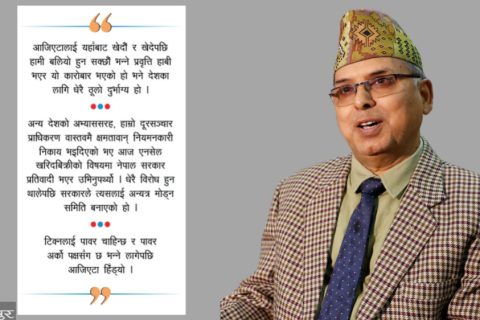Dr Bipin Adhikari
Witchcraft is defined on the basis of the act of witches by Evans-Pritchard (1937) as “A witch performs no rite, utters no spell, and possesses no medicines. An act of witchcraft is a psychic act”. He also described that witches do not know their being a witch until and unless they are accused of being the witch. The difference is that witches in Nepal are supposed to be known their magic power unlike mentioned by Evans.
Meaning of the witchcraft has been explained as “an innate quality, an evolutionary personal trait, deriving from a physiological peculiarity which can be discovered by autopsy” by Thomas (1971:41). He further explains that the witch exercise is malevolent power by accult means, and needs no words, rite, spell or potion. His is a purely psychic act. Eriksen (2001: 217) mentions that “unlike magic, which involves medicines and magical formulas, witchcraft is a purely spiritual, generally involuntary activity: the witchcraft power frequently commits its act while the carrier (the witch) is asleep”.
Witchcraft is a matter of concern to the civilization of people. It generally gives the glimpses of the society and helps to measure the degree of civilization, sometimes. In the context of Nepal, though witchcraft is taken as an undesirable and harmful phenomenon for the society, it still exists in some of the rural areas. Some cases of witchcrafts can be read in the newspapers in those areas and it is regarded as the destructive magical activity of women in the society. One such example is the Marani Devi Case from the eastern plain district of Mahottari, who hit the headlines last year after being bludgeoned by locals who branded her a witch, wants to launch a nation-wide campaign against conservatism.
In light of this, the new Witchcraft Act was prepared by Nepal’s Ministry of Women, Children and Social Welfare (MoWCSW), a federal department dedicated to the legal protection of that particular segment of the population. NHRC recommended the government to provide separate compensation mechanisms to the victims of witchcraft allegations in light of the failure to provide safety and security to the citizen by the state. Secondly, the NHRC recommended to the government draft a legislation criminalizing witchcraft allegations. These recommendations have been implemented by the government and as a result the bill has been promulgated addressing both the concerns of the NHRC.
In light of this, some of the provisions of the bill are highlighted as follows: Firstly, this bill will be specific legislation which shall deal with the issues of witchcraft. There was no any specific legislation regarding the offense of witchcraft and to solve the offense. Secondly, the bill contains provisions that ensure interim relief and protection measures to the victims while legal proceedings take their course. There were no any interim relief packages under the previous laws explained in the Chapter of Decency of National code. The victim is entitled to receive the compensation only after the charge is proved. But this bill has made interim relief protection whereby the victim can sustain his/her life even in absence of family or social support. Thirdly, the bill has a clear focus on victim protection mechanisms and guarantees state protection for the victim. There are no any other laws which shall talk about the victim protection in specific. This bill has given all the efforts to protect the victim even during the course of investigation and charges against the offender.
This bill shall ask the state for spate amount of budgeting to protect the victim of witchcraft. And lastly but not least, the bill includes third-party complaint mechanisms and an ordinance for ranking police officers to investigate complaints. This is most unique features of this bill where by any other parties can make complaint in case the victim is not in condition to lodge the complaint.
In addition, this is the first time that the Nepalese government has legislated the meaning of the term witchcraft. While that definition may be a far cry from that found in the U.S. or Europe, the effort will potentially alleviate some of problems and, thereby, open opportunities for more progressive and aggressive work towards eradicating the problem.
Some of the recommendations for amendments to the bill are as follows:
a) The provisions in Sec. 7 ” Ga” which allows for the arrest of an accused without warrant. According to experts, this is in contrast to the principles of criminal justice theory and should be avoided from the bill altogether.
b) The name “Witchcraft” Bill validates the negative connotation it represents in our society. Further, the term “witch” used in the bill is gender discriminatory as it depicts a situation only referring to a woman whereas both men and women are affected by allegations of witchcraft.
c)Witchcraft allegations usually involve a community rather than individuals. Although, such allegations might initiate at an individual level but it mostly manifests into a communal issue involving multiple people. In light of this, there should be mechanisms to hold the whole community accountably at large rather than individual perpetrators.
d)Further, experts have advocated for the prompt enacting of the victim protection and the witness protection legislation to provide added support to the victims as well as witnesses of torture dished out alleging witchcraft.
e)Also, there is a need for psychological counselling for the victims in light of serious traumatic nature of the crime. According to experts, it is not enough to provide compensation to the victims; rather the focus should be to successfully rehabilitate victims back into society. In that regard, counselling should be provided to the family members of the victims as well as awareness programs should be implemented at the grass-root levels.
f)The new Nepal law makes the accusations illegal but also fails to specifically recognize or allow for Witchcraft as a legitimate magical practice found within folk religious traditions or modern Paganisms.
g)Compared to the Muluki Ain of 1963, the proposed bill has recommended stern punishment against those found guilty of witchcraft related crimes. Depending on the degree of the crime, the proposed bill has penalty and fine ranging from a year to 10 years in prison and Rs 10,000 to Rs 100,000, respectively. The convicted cannot escape jail sentence. The existing country code penalises the accuser with an imprisonment of three to two years or a fine of Rs 5,000 to Rs 25,000, or both. However, the wording “That ‘or’ conjunction is a problem. A perpetrator could walk away after paying the minimum fine. The removal of the options in penalty in the proposed bill will encourage victims to seek justice.
h)The other problem lies with the police administration, members of which belong to the same society that believes in the existence of witches. In such cases, instead of sympathy and provisions for counselling, the police personnel wonder if the victim was really a witch because there can’t be smoke without a fire. There is a need to train the security personnel to not be susceptive to mythical notions.
i)Part 3, Section 5: Medical Attention. There should be provision to provide medical attention to victims suffering from mental disabilities free of cost.
j)Part 3, Section 9: Witch-craft Allegation and Victim Protection. The provision should be amended to provide free of cost counselling to victims.
k)Part 4, Section 11. Compensation. Section 11 ( a) should be amended to include harsher sanction of 3-6 years jail sentence and fine of Rs. 30,000 to 50,000 NPR.
l) Part 4, Section 13. Compensation. There should be provision for a trust fund to provide compensation to the victims in case the accused is financially unable to do so.
m)Part 5, Section 14 (1): Miscellaneous. The provision to provide service centres to victims should be modified to include an establishment to such centres in all the 75 districts.
n)Similarly, there should be mechanisms for enabling the victims to become self-sufficient and provide training and skills sessions if needed.
With the new Witchcraft Act in place, the NGO advocacy groups and the Ministry will have another tool in their pocket to support their work. While the law is certainly not full proof, it does provide the legal fuel needed in their fight to protect the rights and health of the women of Nepal. Over time, this Act and others like it may lead to opportunities for inter-cultural work and inter-religious education that will grow a better global understanding of the many meanings of Witchcraft.
Moreover, there should be provisions of one-door crisis management centres, closed court hearing for the victims of serious offence of GVB, introduction of new legal framework to provide recognition to the household tasks executed by women as well as strict implementation of law to combat social ills like dowry system, prevalent in Nepal. This tackling of the problem in the broader context will aid the process of nationwide abuses.







